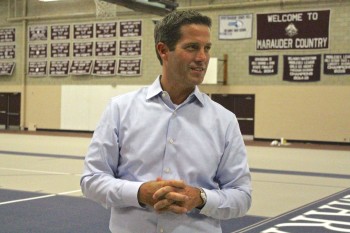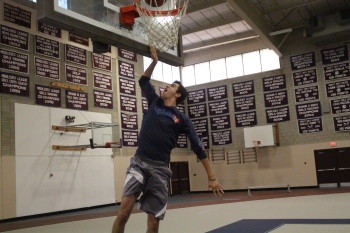Photo: Sleep deprivation among adolescents is a chronic problem across the country and here in Belmont.
By Andrea Prestwich and Steve Saar, Belmont Start School Later
For one Belmont High School senior, the beginning of the school year – which starts today, Wednesday, Sept. 2 – is a double edge sword; the excitement of their final year in the public schools is dampened in trying to stay awake to enjoy the moment.
“It’s really difficult to maintain your focus in class when you don’t get enough sleep. Belmont High School is a great school with high standards, but it’s difficult to keep up when you’re chronically tired,” the senior said, who manages to sleep seven hours on a “good” night.
Our daughter is another example. She is a 12-year-old Chenery Middle School student who says she feels “heavy, slow, grumpy and lethargic” on most school mornings.
What’s wrong with these kids? As it turns out, NOTHING! Many – if not most – middle and high school students in Belmont struggle with chronic sleepiness as they are forced out of bed at 6:30 a.m. or earlier to get to school.
Numerous scientific studies have shown that as kids hit puberty their sleep rhythms change. They naturally fall asleep later and get up later. Asking a teen to get up at 6:30 a.m. is like asking an adult to get up at 4 a.m.; they are deep into their natural sleep cycle. Studies also show adolescents need eight-and-a-half to nine-and-a-half hours of sleep each night.
Depriving kids of sleep at such a crucial period of their development can lead to serious long-term health consequences, including:
- increased risks of obesity
- diabetes
- hypertension
- stroke
- depression
- anxiety
- substance abuse
- Accidents while driving.
Sleep deprivation among adolescents is a chronic problem across the country, linked to poor impulse control and self-regulation – sleepy kids make bad decisions – impairments in attention and memory and deficits in abstract thinking.
Student athletes are especially impacted by sleep deprivation. A study highlighted by the American Academy of Pediatrics showed that “athletes who slept eight or more hours each night were 68 percent less likely to be injured than athletes who regularly slept less.”
The scale of the problem has been recognized by the Center for Disease Control, the American Academy of Pediatrics, the American Psychological Association, the Society for Pediatric Nurses, the National Association of School Nurses, and the National Sleep Foundation, all endorsing later school start time, with middle and high schools opening no earlier than 8:30 a.m.
So, with just about every professional medical organization in the country endorsing later school start times, why does Belmont begin the Chenery day at 7:55 a.m. and Belmont High at 7:35 a.m?
Sometimes the reason is economics. Many schools set start times decades ago to save transportation costs by running the same busses in three cycles for the high school, middle school and elementary school. Starting schools early also leaves more time in the afternoon for athletics and other after-school activities.
The current schedule would make sense if adolescents had a “sleep mode” button, but sadly, evolution has not seen fit to equip them with one. You just can’t put teens to bed at 9:30 p.m. and expect them to go to sleep immediately and wake bright and early at 6 a.m. as the schedule is contrary to their natural sleep rhythms.
If you put teens to bed at 9:30 p.m. they will toss and turn until 11 p.m. when they will finally start to feel drowsy. The adage “early to bed and early to rise” doesn’t apply to adolescents; they are creatures of the night!
So why not change Belmont to a healthier, later schedule? First, there’s a widespread belief that if schools start later kids will stay up later. This is not true. A landmark study looked at 18,000 high school students in Minneapolis before and after the district’s school start time changed from 7:15 a.m. to 8:40 a.m. The main conclusion was that high school students slept an hour longer on average when their school started later. They went to bed at the same time as before the time change and slept longer.
Athletics is another consideration. Currently, schools in the Middlesex League have early starting times. If Belmont were to shift to a healthier, later schedule, our athletes would be out of sync with the rest of the league. Practice times would also have to change, possibly causing a ripple effect and impacting youth groups who use the same facilities.
Other barriers to a later schedule include the need to re-think before- and after-school programs and the impact on some kids with part-time jobs.
There are certainly obstacles to shifting Belmont High and the Chenery to start later but none is insurmountable. For example, bus schedules could be reversed so that Winn Brook starts first at around 7:45 a.m., then the High School just after 8:30 a.m., Wellington, and Chenery later. Elementary school kids are usually up with the larks, bouncing on their beds – they have sleep rhythms naturally suited to an earlier start.
Start School Later has local chapters across Massachusetts working for later start times, and we are working with Massachusetts legislators. Hopefully, Belmont will join other districts as they shift times.
Even though there are difficulties in changing school start times, it is not acceptable for our kids to be sleep deprived, any more than it is acceptable for them to go without food or any other life necessity. And sleep is a necessity of life. Our kids should start the school day well fed and rested. The current start times make this impossible.
School districts around the country have shifted to healthier schedules with very positive results: kids are more alert and less grumpy, there are lower rates of tardiness and fewer missed school days. They arrive at school ready to learn.
We ask Belmont School Superintendent John Phelan and the Belmont School Committee follow the recommendations and shift Belmont schools to healthier schedules.

